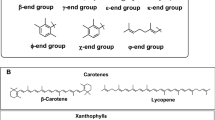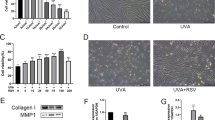Abstract
To examine the possibility of luteolin as a whitening agent, we measured antioxidant activity using DPPH assay, NBT/XO assay and intracellular ROS scavengning assay and depigmenting activity using tyrosinase assay, α-MSH-induced melanin production in B-16 cells. Luteolin showed dose-dependent anti-oxidant activity in DPPH, NBT/XO and intracellular ROS assay. Also, luteolin directly inhibited xanthine oxidase activity in a dose-dependent manner. Although luteolin did not directly inhibit tyrosinase activity, it dose-dependently inhibited both tyrosinase activity and melanin production in B16 melanoma cells stimulated by 1 μM α-MSH. Luteolin dose-dependently inhibited cAMP levels in B16 melanoma cells stimulated by 1 μM α-MSH and 1 μM forskolin, which suggest that luteolin directly inhibits adenyl cyclase in B16 melanoma cells. Therefore, these results suggest that whitening activity of luteolin may be due to the inhibition of adenyl cyclase involved in the signal pathway of α-MSH in B16 melanoma cells.
Similar content being viewed by others
References
Agin, P. P., Dowdy, J. C., and Costlow, M. E., Diacylglycerol-induced melanogenesis in Skh-2 pigmented hairless mice. Photodermatol Photoimmunol Photomed., 8, 51–56 (1991).
Boland, A., Delapierre, D., Mossay, D., Hans, P., and Dresse, A., Propofol protects cultured brain cells from iron ion-induced death: comparison with trolox. Eur. J. Pharmacol., 404, 21–27 (2000).
Cos, P., Rajan, P., Vedernikova, I., Calomme, M., Pieters, L., Vlietinck, A. J., Augustyns, K., Haemers, A., and Berghe, D. V., In vitro antioxidant profile of phenolic acid derivatives. Free Radic. Res., 36, 711–716 (2002).
Donsing, P., Limpeanchob, N., and Viyoch, J., Evaluation of the effect of Thai breadfruit’s heartwood extract on melanogenesis-inhibitory and antioxidation activities. J. Cosmet. Sci., 59, 41–58 (2008).
Friedmann, P. S. and Gilchrest, B. A., Ultraviolet radiation directly induces pigment production by cultured human melanocytes. J. Cell. Physiol., 133, 88–94 (1987).
Friedmann, P. S., Wren, F. E., and Matthews, J. N., Ultraviolet stimulated melanogenesis by human melanocytes is augmented by di-acyl glycerol but not TPA. J. Cell. Physiol., 142, 334–341 (1990).
Gordon, P. R., Mansur, C. P., and Gilchrest, B. A., Regulation of human melanocyte growth, dendricity, and melanization by keratinocyte derived factors. J. Invest. Dermatol., 92, 565–572 (1989).
Griffiths, C. E., Finkel, L. J., Ditre, C. M., Hamilton, T. A., Ellis, C. N., and Voorhees, J. J., Topical tretinoin (retinoic acid) improves melasma. A vehicle-controlled, clinical trial. Br. J. Dermatol. 129, 415–421 (1993).
Harris, G. K., Qian, Y., Leonard, S. S., Sbarra, D. C., and Shi, X., Luteolin and chrysin differentially inhibit cyclooxygenase-2 expression and scavenge reactive oxygen species but similarly inhibit prostaglandin-E2 Formation in RAW 264.7 Cells. J. Nutr., 136, 1517–1521 (2006).
Hougee, S., Sanders, A., Faber, J., Graus, Y. M. F., van den Berg, W. B., Garssen, J., Smit, H. F., and Hoijer, M. A., Decreased pro-inflammatory cytokine production by LPS-stimulated PBMC upon in vitro incubation with the flavonoids apigenin, luteolin or chrysin, due to selective elimination of monocytes/macrophages. Biochem. Pharmacol., 69, 241–248 (2005).
Hunt, G., Todd, C., Cresswell, J. E., and Thody, A. J., Alphamelanocyte stimulating hormone and its analogue Nle4-DPhe7 alpha-MSH affect morphology, tyrosinase activity and melanogenesis in cultured human melanocytes. J. Cell. Sci., 107, 205–211 (1994).
Ju, W., Wang, X., Shi, H., Chen, W., Belinsky, S. A., and Lin, Y., A Critical Role of Luteolin-Induced Reactive Oxygen Species in Blockage of Tumor Necrosis Factor-Activated Nuclear Factor-kB Pathway and Sensitization of Apoptosis in Lung Cancer Cells. Mol. Pharmacol., 71, 1381–1388 (2007).
Kim, K. A., Kim, Y. H., Seo, M. S., Lee, W. K., Kim, S. W., Kim, H. T., Lee, K. H., Shin, I. C., Han, J. S., Kim, H. J., and Lim, Y., Mechanism of silica-induced ROS generation in Rat2 fibroblast cells. Toxicol. Lett., 135, 185–191 (2002).
Kim, Y. J., Antimelanogenic and antioxidant properties of gallic acid. Biol. Pharm. Bull. 30, 1052–1055 (2007).
Maeda, K. and Fukuda, M. Arbutin: mechanism of its depigmenting action in human melanocyte culture. J. Pharmacol. Exp. Ther., 276, 765–769 (1996).
Mishima, Y., Hatta, S., Ohyama, Y., and Inazu, M. Induction of melanogenesis suppression: cellular pharmacology and mode of differential action. Pigment Cell Res. 1, 367–374. (1988).
Nguyen, M. T. T., Awale, S., Tezuka, Y., Tran, Q. L., Watanabe, H., and Kadota, S., Xanthine Oxidase Inhibitory Activity of Vietnamese Medicinal Plants. Biol. Pharm. Bull., 27, 1414–1421 (2004).
Nagao, A., Seki, M., and Kobayashi, H., Inhibition of Xanthine Oxidase by Flavonoids. Biosci. Biotechnol. Biochem., 63, 1787–1790 (1999).
Pinto, C., Papa, D., Hubner, M., Mou, T. C., Lushington, G. H., and Seifert, R., Activation and inhibition of adenylyl cyclase isoforms by forskolin analogs. J. Pharmacol. Exp. Ther., 325, 27–36 (2008).
Shi, R., Huang, Q., Zhu, X., Ong, Y. B., Zhao, B., Lu, J., Ong, C. N., and Shen, H. M., Luteolin sensitizes the anticancer effect of cisplatin via c-Jun NH2-terminal kinase-mediated p53 phosphorylation and stabilization. Mol. Cancer Ther., 6, 1338 (2007).
Smith, P. K., Krohn, R. I., Hermanson, G. T., Mallia, A. K., Gartner, F. H., Provenzano, M. D., Fujimoto, E. K., Goeke, N. M., Olson, B. J., and Klenk, D. C., Measurement of protein using bicinchoninic acid. Anal. Biochem., 150, 76–85 (1985).
Woerdenbag, H. J., Merfort, I., Passreiter, C. M., Schmidt, T. J., Willuhn, G., van Uden, W., Pras, N., Kampinga, H. H., and Konings, A. W., Cytotoxicity of flavonoids and sesquiterpene lactones from Arnica species against the GLC4 and the COLO 320 cell lines. Planta Med., 60, 434–437 (1994).
Wong, G. and Pawelek, J., Melanocyte-stimulating hormone promotes activation of pre-existing tyrosinase molecules in Cloudman S91 melanoma cells. Nature., 255, 644–646 (1975).
Ziyan, L., Yongmei, Z., Nan, Z., Ning, T., and Baolin, L., Evaluation of the anti-inflammatory activity of luteolin in experimental animal models. Planta Med., 73, 221–226 (2007).
Author information
Authors and Affiliations
Corresponding author
Rights and permissions
About this article
Cite this article
Choi, M.Y., Song, H.S., Hur, H.S. et al. Whitening activity of luteolin related to the inhibition of cAMP pathway in α-MSH-stimulated B16 melanoma cells. Arch. Pharm. Res. 31, 1166–1171 (2008). https://doi.org/10.1007/s12272-001-1284-4
Received:
Revised:
Accepted:
Published:
Issue Date:
DOI: https://doi.org/10.1007/s12272-001-1284-4




